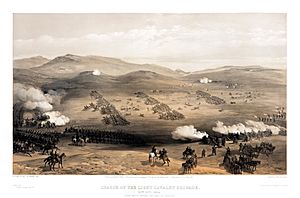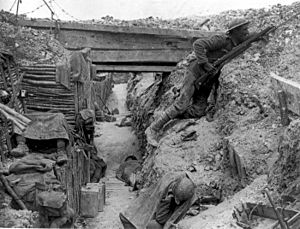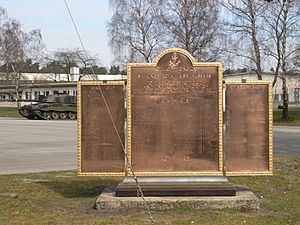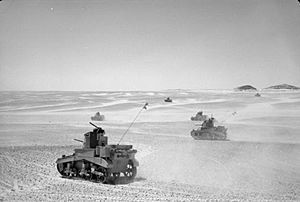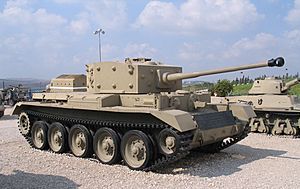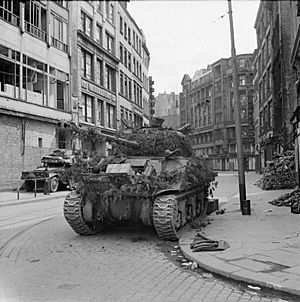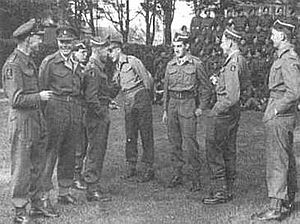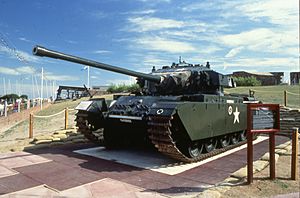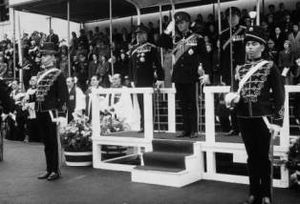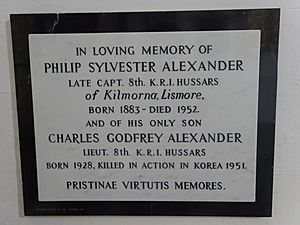8th King's Royal Irish Hussars facts for kids
Quick facts for kids 8th (King's Royal Irish) Hussars |
|
|---|---|
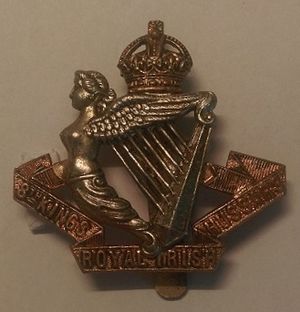
Crest of the 8th King's Royal Irish Hussars
|
|
| Active | 1693–1714 1715–1716 1719–1958 |
| Country | |
| Branch | |
| Type | Cavalry of the Line/Royal Armoured Corps |
| Role | Light cavalry |
| Size | 550 men |
| Regimental Headquarters | London |
| Nickname(s) | The Crossbelts |
| Motto(s) | Pristinae virtutis memores |
| March | Quick: The Galloping 8th Hussar Slow: The Scottish Archers |
| Anniversaries | Balaklava Day St Patrick's Day |
| Commanders | |
| Colonel-in-Chief | HRH Prince Philip |
The 8th King's Royal Irish Hussars was a famous cavalry regiment in the British Army. It was first formed way back in 1693. This regiment served for over 250 years, fighting in the First and Second World War. They also fought bravely in the Korean War. In 1958, the regiment joined with the 4th Queen's Own Hussars. Together, they became the Queen's Royal Irish Hussars.
Contents
- A Long History: From Dragoons to Hussars
- Starting Out: The War of Spanish Succession
- Disbanded and Re-formed: 1713–1796
- Adventures in South Africa and India: 1796–1854
- The Crimean War: A Famous Charge
- The Indian Rebellion of 1857
- Peace and the Second Boer War: 1863–1914
- The First World War: Trench Warfare
- Between the Wars: Motorized Cavalry
- The Second World War: Desert Rats and Normandy
- The Korean War: Centurion Tanks
- Joining Forces: Amalgamation
- Regimental Museum
- Battle Honors
- Famous People from the Regiment
- Regimental Leaders (Colonels)
- See also
A Long History: From Dragoons to Hussars
Starting Out: The War of Spanish Succession
The regiment began in 1693 in Derry, Ireland. It was called Henry Conyngham's Regiment of Dragoons. Dragoons were soldiers who rode horses but could also fight on foot. They were the 8th Dragoons in the army.
In 1704, they went to Spain to fight in the War of the Spanish Succession. Their leader, Henry Conyngham, was killed in a small fight. Another leader, Robert Killigrew, also died at the Battle of Almansa in 1707.
Under a new leader, John Pepper, the 8th Dragoons won a big victory. At the Battle of Almenar in 1710, they defeated a Spanish cavalry group. It's said they took the enemy's crossbelts as trophies. This gave them the nickname "Crossbelt Dragoons." Later that year, the whole regiment was captured at the Battle of Brihuega.
Disbanded and Re-formed: 1713–1796
The regiment returned home and was disbanded in 1714. But it was re-formed just one year later in 1715. They went to Scotland to help stop the Jacobite rising of 1715. They also helped again during the Jacobite rising of 1745.
In 1751, they officially became the 8th Regiment of Dragoons. In 1775, they got their first special name: "The 8th King's Royal Irish Light Dragoons." Two years later, they were named after King George III. They became the 8th (The King's Royal Irish) Regiment of (Light) Dragoons.
In 1794, they fought in the Low Countries (modern-day Belgium and Netherlands). They captured French guns in a fight at Bousbecque. King George III honored them by telling them to wear buff-colored gear. They returned to England in 1795.
Adventures in South Africa and India: 1796–1854
In 1796, the regiment went to South Africa to help control the Boers. Then they moved to North Africa. In 1802, they sailed to India. Their mission was to stop local leaders like Daulat Scindia and Yashwantrao Holkar.
They fought at the Battle of Laswari in 1803, where Scindia was defeated. Holkar gave up after many of his men died in 1805. A peace treaty was signed in 1806. In 1812, the regiment attacked two forts belonging to rebellious groups called Pindaris.
In 1814, they faced the Gurkhas who were trying to expand Nepal. Their leader, Colonel Rollo Gillespie, was killed in a fight at Kalunga. His horse, Black Bob, became a special mascot for the regiment.
In 1818, the regiment changed from Dragoons to Hussars. Hussars were a type of light cavalry known for their fancy uniforms. They were renamed the 8th (The King's Royal Irish) Regiment of (Light) Dragoons (Hussars). They returned to England in 1819. In 1849, they even escorted Queen Victoria and Prince Albert on their first visit to Dublin.
The Crimean War: A Famous Charge
The 8th Hussars played a big part in the Crimean War. They were part of the famous Charge of the Light Brigade. In March 1854, they sailed from England to the Black Sea. Five ships were needed to carry them and their horses.
They won a battle near the River Alma in September 1854. This victory earned them a special "battle honor." Later, they helped capture Russian wagons filled with supplies near Balaklava.
The most famous event was the Charge of the Light Brigade in October. About 25,000 Russians tried to capture Balaklava, which was the British Army's only port. The 8th Hussars were in the third line of the charge. They rode straight into heavy enemy fire.
One officer described the charge: "The pace of our Cavalry increased every moment, until they went thundering along the valley... On they went headlong to death." Even though many were lost, the remaining soldiers fought bravely.
The 8th Hussars pushed through the Russian gun lines. They lost half their men. The remaining 70 soldiers decided to attack Russian lancers and defeated them. This allowed the brigade to retreat. In total, the 8th Hussars lost 2 officers and 19 soldiers killed. Many more were wounded or captured.
The Battle of Inkerman was won by the infantry in November. Then a harsh winter began, killing many soldiers. But the 8th Hussars still defeated the Russians at Kertch. In September 1855, Sevastopol fell, and a peace treaty was signed in March 1856.
Out of 293 soldiers who went to the Crimea, only 154 returned home. Many died from wounds or disease. Only 30 of their 230 horses came back.
The Indian Rebellion of 1857
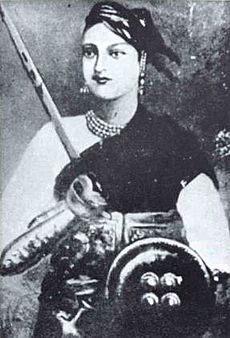
After a year in England, the 8th Hussars were sent to India. They helped put down the Indian rebellion of 1857. In May 1858, a group of 8th Hussars, led by Captain Heneage, fought a large Indian force. This force was led by Rani Lakshmibai, the Queen of Jhansi.
The 8th Hussars charged, killing many Indian soldiers. They captured two guns and rode through the enemy camp. Rani Lakshmibai, dressed as a cavalry leader, was badly wounded. She asked a hermit to burn her body so the British wouldn't capture it.
For their bravery, four soldiers from the squadron were awarded the Victoria Cross. This is the highest military award for bravery. The soldiers chosen were Captain C W Heneage, Sergeant J Ward, Farrier G Hollis, and Private J Pearson. Their bravery was officially recognized in January 1859.
The regiment continued to chase rebel forces. In September 1858, they defeated mutineers at Beejapore, killing 450 enemy soldiers. Troop Sergeant-Major James Champion also won the Victoria Cross for his bravery there.
By May 1859, the 8th Hussars had marched over 3,000 miles in India. In 1861, their name was simplified to the 8th (The King's Royal Irish) Hussars.
Years later, in 1994, a Victoria Cross medal was found in Ireland. It was believed to belong to either George Hollis or John Pearson. The 8th Hussars were based there between 1869 and 1875.
Peace and the Second Boer War: 1863–1914
The regiment returned to India in 1879. Then they went to Afghanistan to support Lord Roberts' army in the Second Anglo-Afghan War. They came home in 1889.
In October 1899, the Second Boer War began in South Africa. The regiment sailed there in February 1900. They fought in several battles, including one at Houtnek in May 1900. Lord Roberts praised the 8th Hussars for their service.
They also fought near Geluk in October, where they held their ground against a large enemy force. They lost 2 officers and 7 men. Many officers and soldiers were mentioned for their bravery.
After the war, the 8th Hussars had six years of peace. In August 1914, they returned to India. But they were soon called back because the First World War had started. They arrived in France in November 1914.
The First World War: Trench Warfare
The 8th Hussars entered the trenches on the Western Front in December 1914. Their first battle was at Givenchy. Most of their time was spent digging trenches. This continued throughout the war.
In May 1915, they fought in the Second battle of Ypres. This was where the Germans first used chlorine gas. In September 1915, the 8th Hussars moved to another cavalry division.
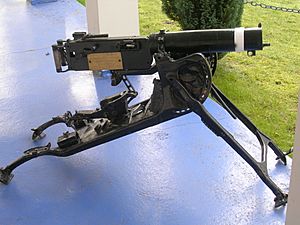
Most soldiers were hurt or killed by the terrible conditions in the trenches. The cavalry was mostly kept in reserve, waiting for a chance to break through. In July 1916, they fought at Bazentin and Flers-Courcelette in the Somme area.
In March 1917, they returned to the Somme. They cleared out German machine gun positions. They made their last mounted charge at Villers-Faucon. B and D Squadrons attacked a strong German position. B Squadron charged, then fought on foot. D Squadron charged and captured the village with few losses. Two Maxim machine guns were captured. These guns have been kept by the regiment ever since.
During the German attack in 1918, "C" Squadron defended Hervilly. They were forced to retreat but recaptured it later that day. They lost 66 soldiers.
In March 1918, they joined the 1st Cavalry Division. The Germans began to lose ground in August. The 8th fought at St Quentin, Beaurevoir, Cambrai, and in the Pursuit to Mons. On November 11, 1918, the Armistice (peace agreement) was signed.
The 8th Hussars lost 105 soldiers killed during the war. They created a memorial for those who died. This memorial now includes names from the Second World War and the Korean War. It is displayed with their successor regiment.
Between the Wars: Motorized Cavalry
The 8th Hussars returned to England in 1919. They soon went to India for less than a year. Then they were sent to Mesopotamia (modern-day Iraq) to deal with local uprisings. After that, they moved to Egypt.
In 1921, the regiment was officially renamed the 8th King's Royal Irish Hussars. In 1923, they moved back to York, England. From 1926 to 1929, they were part of the forces occupying Germany.
They returned to Aldershot and got their first motorized vehicles. These were for their machine-gun squadron. In 1934, the 8th moved to Abassia in Egypt. Their long history with horses was ending after 242 years. Their horses were replaced with Ford V8 pickup trucks. These trucks had Vickers Berthier machine guns.
Their last parade with horses was in the desert near Cairo in November 1935. In 1936, the regiment helped calm unrest in Palestine. Then they returned to Egypt.
The Second World War: Desert Rats and Normandy
Fighting in the Desert
In 1938, the regiment joined the Mobile Division. This later became the famous 7th Armoured Division, nicknamed The Desert Rats. In January 1939, they received light tanks. They officially joined the Royal Armoured Corps. Their band was even turned into an Anti-Tank Troop.
In May 1939, they prepared for war after Italy invaded Albania. They started wearing black berets instead of their old cavalry hats. In August 1939, they went into the desert to prepare defenses.
The regiment fought against the Italian Army in North Africa in June 1940. They captured Sidi Omar, Fort Capuzzo, and Fort Maddalena. They also fought at Sidi Barrani, capturing 14,000 prisoners. They helped surround Tobruk.
In February 1941, they were part of the important Battle of Beda Fomm. This led to the capture of most Italian forces in North Africa. In March 1941, the 8th Hussars briefly served in Greece. Then they returned to North Africa.
In July 1941, the 8th Hussars, using Stuart tanks, fought in Operation Crusader. During the Battle of Sidi Rezegh Airfield, they were attacked at night. They lost 35 tanks and were left with only four. They got 32 new Stuarts and returned to the battle.
On December 1, they charged "cavalry style" again at Sidi Rezegh. Their leader, Major Sandbach, was killed. After getting new tanks (some Grant and some Stuarts), they fought in the Gazala battles in May and June 1942. They suffered heavy losses at the Battle of Knightsbridge.
The 8th fought hard with another regiment, the 4th City of London Yeomanry. They had to retreat with the rest of the British Eighth Army to El Alamein. In June, a part of the regiment joined the 4th Queen's Own Hussars. They formed a temporary regiment called the 4th/8th Hussars.
This combined unit faced a huge enemy attack at Alam Halfa and won. They helped break through minefields at the Second Battle of El Alamein. Then they chased the enemy for three weeks. After a short time in Cyprus, they returned to England.
Normandy and Beyond
Back in England, the regiment got new Cromwell tanks. They trained in Norfolk. In November 1943, they became the armored reconnaissance regiment for the 7th Armoured Division.
On June 9, 1944, they sailed to the Normandy beaches in France. They landed at Le Hamel on Gold Beach. They immediately went into action, fighting around Villers-Bocage. They advanced through the Bocage region, fighting the 2nd Panzer Division.
They also fought hard around Briquessard. They took part in Operation Goodwood and other smaller battles. The 8th pushed German forces back. They helped close the Falaise pocket, suffering more losses.
Reinforced by another squadron, they pushed through France. They broke out into the Low Countries, entering Belgium on September 11, 1944. They entered the Netherlands on September 23. They fought hard at St Pol, the Nederrijn, and the Maas River.
After wintering by the Maas, they helped the Rifle Brigade as infantry. They painted their vehicles white, including their new Sherman Firefly tanks and Chaffee tanks. They prepared to fight the German attack in the Ardennes (the Battle of the Bulge).
The Irish Hussars continued their advance across the Netherlands. In April 1945, the 8th crossed the Weser River. They liberated a POW camp at Fallingbostel. They ended the war near Hamburg.
On July 7, 1945, the regiment went to Berlin for the Victory celebrations. They were the second most senior British Army regiment on parade. They stayed in Germany for a year, helping with security.
The Korean War: Centurion Tanks
In 1948, the 8th returned to England. In 1950, when the Korean War started, they were sent to Korea. They quickly learned to use Centurion MkIII tanks. They sailed from England in October 1950.
They reached the front line north of Pyongyang. All squadrons soon found themselves retreating. They regrouped on the Han River. In early 1951, their Recce Troop (reconnaissance) fought on the Han River. They lost 23 soldiers. A Cromwell tank was captured by the Chinese. It had to be destroyed by the Hussars' own Centurions.
In February, the United Nations forces attacked. They helped the Glosters capture Hill 327. By April 1951, patrols were moving north of the Imjin River. Then a huge enemy attack began the Battle of the Imjin River on April 22, 1951.
The 8th was supposed to return to the UK. But the Chinese attack started. A and B Squadrons were ordered back to Korea. C Squadron, led by Captain Peter Ormrod, was left to fight alone.
The tanks fought the attacking Chinese for several days. They tried to stop the Chinese from taking important hills. These hills were defended by the Glosters, the Northumberland Fusiliers, and the Royal Ulster Rifles. The 8th had to make daring trips into enemy-held areas. They rescued infantry soldiers cut off by the Chinese.
The fighting was very fierce. One tank commander, Richard Napier, remembered his machine gun barrels needing changing. His loader had fainted from the hard work and fumes. His tank was swarmed by Chinese soldiers. The crew threw grenades out of the hatches to fight them off.
The Centurion tanks of the 8th were covered in Chinese soldiers trying to open the hatches. The Hussars turned their tank turrets towards each other. They used their Besa machine guns to "hose" the enemy off. When they returned, their tanks were "red with the blood of dead Chinese."
Major Henry Huth received the DSO for his part in the Imjin battles. Captain Peter Ormrod won the Military Cross. The Centurions of the 8th Hussars became famous for covering the retreat of the 29th Brigade.
Joining Forces: Amalgamation
Between 1952 and 1958, the 8th King's Royal Irish Hussars were stationed in Lüneburg, Germany. They had a peaceful time. But in 1957, a government plan suggested reducing the army.
In 1958, the regiment joined with the 4th Queen's Own Hussars. They formed a new regiment called the Queen's Royal Irish Hussars.
Regimental Museum
The regiment's collection is moving to a new place in Warwick called "Trinity Mews." It was planned to open in 2018.
Battle Honors
The 8th Hussars earned many special "battle honors" for their bravery. Only 40 of these honors were displayed on their Regimental Guidon (a special flag). The honor of "Hindoostan" was given in 1825 for their service in India from 1802–1822.
- Early Wars: Leswaree, Hindoostan, Alma, Balaklava, Inkerman, Sevastopol, Afghanistan 1879–80, South Africa 1900–02
- First World War: Givenchy 1914, Somme 1916; 1918, Cambrai 1917; 1918, Bapaume 1918, Rosieres 1918, Amiens 1918, Albert 1918, Beaurevoir, Pursuit to Mons, France and Flanders 1914–1918
- Second World War: Villers Bocage, Mont Pincon, Dives Crossing, Nederrijn, Best, Lower Maas, Roer, Rhine, North-West Europe 1944–45, Egyptian Frontier 1940, Sidi Barrani, Buq Buq, Sidi Rezegh 1941, Relief of Tobruk 1941, Gazala, Bir el Igela, Mersa Matruh, Alam el Halfa, El Alamein, North Africa 1940–42,
- Korean War: Seoul, Hill 327, Imjin, Kowang-San, Korea 1950–51
Famous People from the Regiment
- Field Marshal Sir John French, 1st Earl of Ypres
- General Sir Robert "Rollo" Gillespie (1766–1814)
- General Sir John Hackett (British Army officer)
- Lieutenant General James Brudenell, 7th Earl of Cardigan
- Lieutenant the Hon. John Charles Henry Fitzgibbon (killed at Balaklava)
- Captain Bill Bellamy MC (author of Troop Leader: A Tank Commander's Story)
Regimental Leaders (Colonels)
Here are some of the important leaders of the regiment over the years:
- 1693–1706: Maj-Gen. Henry Conyngham
- 1706–1707: Maj-Gen. Robert Killigrew
- 1707–1714: Maj-Gen. John Pepper
- disbanded 1714
- John Pepper's Regiment of Dragoons - (reformed 1715)
- 1715–1716: Maj-Gen. John Pepper (reappointed)
- disbanded 1716
- Phineas Bowles's Regiment of Dragoons - (reformed 1719)
- 1719–1722: Maj-Gen. Phineas Bowles
- 1722–1725: Brig-Gen. Richard Munden
- 1725–1731: F.M. Sir Robert Rich, 4th Bt
- 1731–1733: Maj-Gen. Charles Cathcart, 8th Baron Cathcart
- 1733–1736: Brig-Gen. Sir Adolphus Oughton, Bt
- 1737–1740: Lt-Gen. Clement Neville
- 1740–1755: Lt-Gen. Richard St George
- 8th Regiment of Dragoons - (1751)
- 1755–1758: Gen. John Waldegrave, 3rd Earl Waldegrave
- 1758–1760: Gen. Sir Joseph Yorke, 1st Baron Dover, KB
- 1760–1787: Gen. John Severne
- 8th (The King's Royal Irish) Regiment of (Light) Dragoons - (1777)
- 1787–1789: Gen. Charles Grey, 1st Earl Grey, KB
- 1789–1797: Gen. Francis Lascelles
- 1797–1788: Gen. Charles Grey, 1st Earl Grey, KB (reappointed)
- 1799–1804: Gen. Sir Robert Laurie, Bt
- 1804–1818: Gen. Sir John Floyd, Bt
- 1818–1833: Gen. Sir Banastre Tarleton, Bt., GCB
- 8th (The King's Royal Irish) Regiment of (Light) Dragoons (Hussars) - (1822)
- 1833–1839: Gen. Sir William Kerr Grant, KCB, GCH
- 1839–1840: Lt-Gen. Sir Joseph Straton, CB, KCH
- 1840–1843: Lt-Gen. Philip Philpot
- 1843–1855: Gen. Sir John Brown, KCH
- 1855–1865: F.M. George Charles Bingham, 3rd Earl of Lucan, GCB
- 8th (The King's Royal Irish) Hussars - (1861)
- 1865–1868: Gen. John Lawrenson
- 1868–1875: Gen. John Charles Hope Gibsone
- 1875–1880: Lt-Gen. Rudolph de Salis, CB
- 1880–1886: Gen. William Charles Forrest, CB
- 1886–1886: Lt-Gen. Sir James Robertson Steadman Sayer, KCB
- 1886–1895: Lt-Gen. Sir Charles Craufurd Fraser, Bt., VC, KCB
- 1895–1910: Maj-Gen. William Mussenden
- 1910–1930: Gen. Sir Bryan Thomas Mahon, KCB, KCVO, DSO
- 8th King's Royal Irish Hussars - (1921)
- 1930–1948: Brig. John van der Byl, DSO
- 1948–1958: Col. (Air Marshal) Sir John Eustace Arthur Baldwin, KBE, CB, DSO
See also



